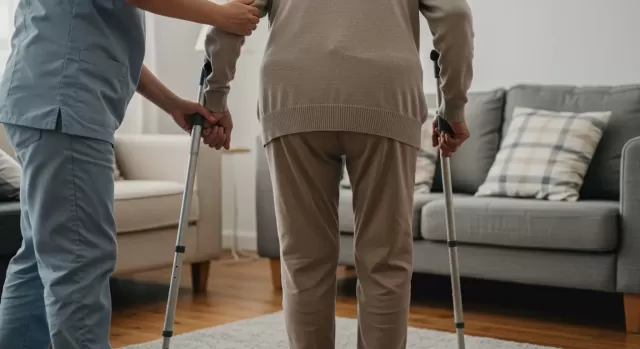Dementia and Posture Changes: Understanding and Management

Dementia is often associated with memory loss and cognitive decline, but it can also manifest in physical ways, impacting a person's posture and movement. These changes, known as dementia posturing, can significantly increase the risk of falls and injuries.
Understanding Dementia Posturing
Dementia posturing involves noticeable changes in how a person stands, walks, and moves. This might include stooping, shuffling, swaying, or even "freezing" mid-motion. These postural changes occur because dementia damages brain cells. As these brain cells die, the brain shrinks, also known as atrophy. This atrophy disrupts the brain's ability to send signals that control movement, balance, and posture. When brain areas like the brainstem or frontal cortex, responsible for these functions, are affected, the signs become more noticeable. Damage to the brainstem can lead to balance problems, muscle weakness, and difficulty walking. Damage to the frontal cortex impacts coordination and muscle control, increasing the risk of falls.
The Risks of Posture Changes
Changes in posture can lead to instability and reduced coordination, making everyday activities more dangerous. This increased risk of falling can lead to fractures, head trauma, and loss of mobility, accelerating both physical and cognitive decline.
Managing Posture Changes in Dementia
Managing dementia posturing requires a comprehensive approach to address both the physical and emotional needs of the individual. While challenging, early identification and supportive care can greatly improve comfort, function, and quality of life.
- Physical Therapy: Physical therapy is vital for maintaining mobility and preventing complications such as muscle contractures, where muscles become stiff. Gentle stretching, range-of-motion exercises, and regular movement can alleviate discomfort and maintain joint flexibility.
- Occupational Therapy: Occupational therapy can help adapt daily activities and provide supportive tools such as cushions, braces, or modified clothing to make care safer and easier.
- Medications: Medications to reduce muscle stiffness or spasms may be considered in some cases, but they should be used cautiously due to potential side effects in older adults.
- Caregiver Support: Caregivers are essential in managing posture changes. Frequent repositioning, supportive bedding, and a structured routine can reduce discomfort and the risk of pressure sores and injury. Encouraging daily activity and a comforting environment can also improve the quality of life.
Frequently Asked Questions (FAQs)
1. What is dementia posturing?
Dementia posturing refers to changes in a person's posture and movement due to brain damage caused by dementia. These changes can include stooping, shuffling, swaying, and difficulty with balance.
2. Why does dementia cause posture changes?
Dementia causes the gradual loss of brain cells. As brain cells die, the brain shrinks, also known as atrophy. This atrophy disrupts the brain's ability to send signals that control movement, balance, and posture. This disruption is the reason a person with dementia might begin to display posture changes.
3. What are the risks associated with dementia posturing?
The main risk associated with dementia posturing is an increased likelihood of falls, which can lead to fractures, head trauma, and reduced mobility.
4. How can dementia posturing be managed?
Dementia posturing can be managed through physical therapy, occupational therapy, medication (used cautiously), and supportive care from caregivers, including frequent repositioning, supportive bedding, and a structured routine.